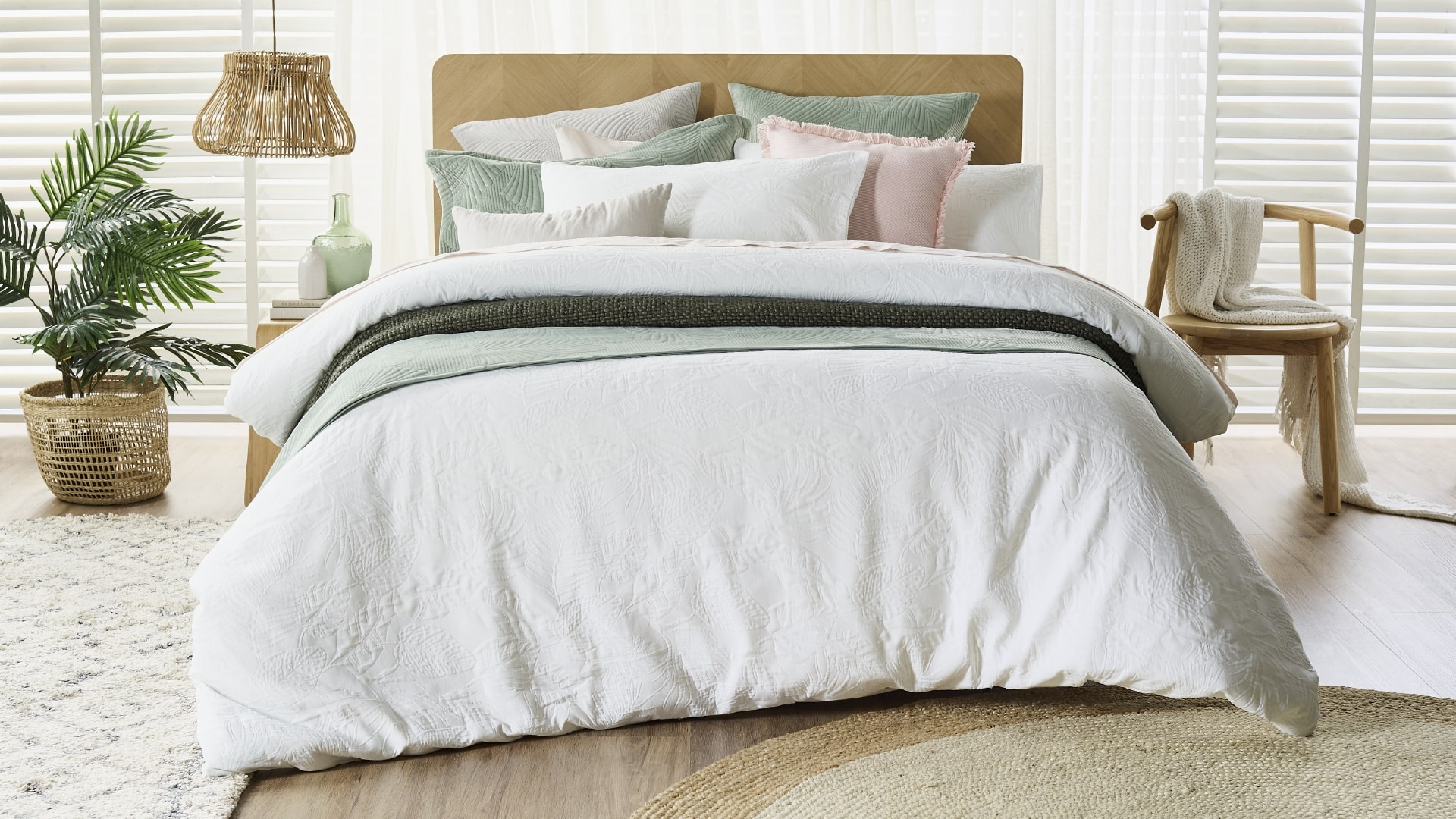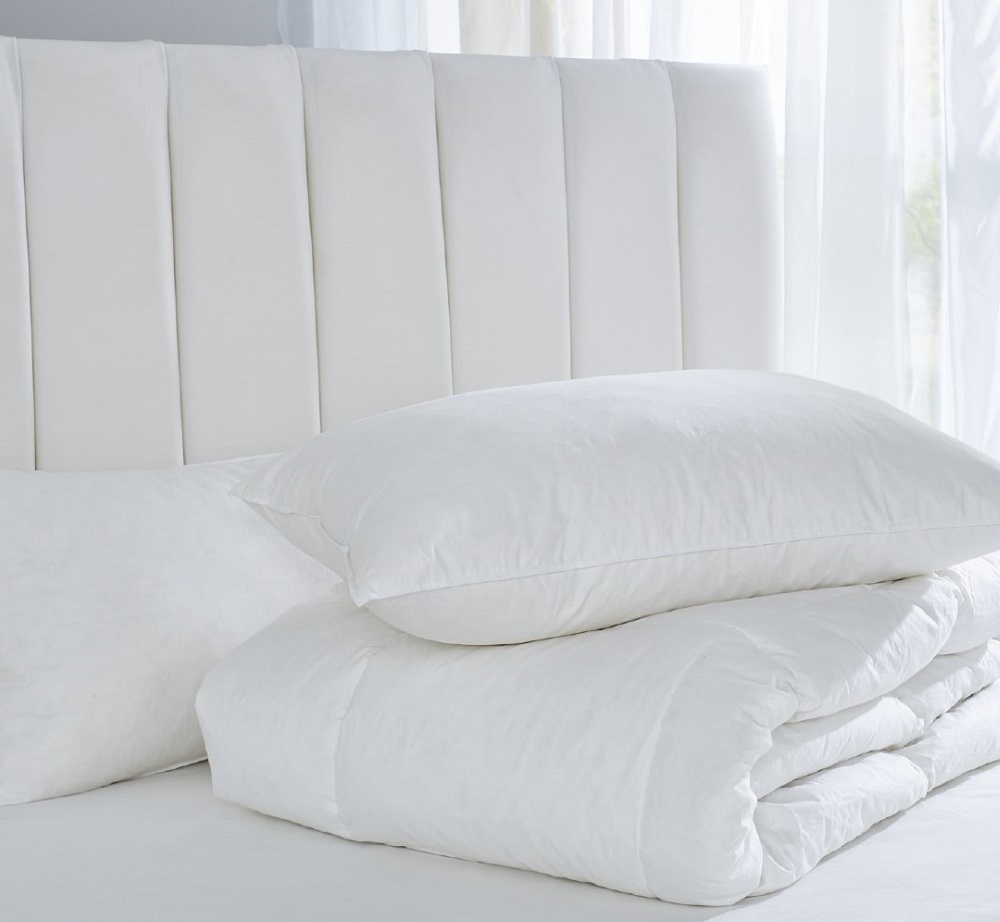 | ||
| Your browser is not supported. | ||
|
Please browse our site using any of the following options:
| ||
What's the best way to care for my quilts, pillows and bed linen?
A good sleep ensures we're happier and healthier people, and our beds should always make us feel safe and comfortable at the end of a long day. Choosing the right quilt or doona, linen and pillows is only the first step. Caring for your bedding is essential for creating a restful and healthy sleep environment.
Starting Point
Your starting point for looking after your quilts, pillows, bed linen and sheets should always be reading the care instructions on their labels. Certain materials are suitable to machine-washing but others may require dry-cleaning. Washing dark colours with lights or whites may also result in dyes running, so it's advisable to wash them separately, especially for the first few times they're cleaned.
There are four main areas to consider when caring for your bedding:
- Washing
- Drying
- Airing
- Storage
Each of these steps plays an important role in keeping your bedroom clean and comfortable.

QUILTS
Washing
Your quilt or doona cover will need regular washing to minimise the impact of moisture and bacterial build-up. If you use a top sheet, monthly washing of your quilt cover should be sufficient. If you do not use a top sheet, wash it more regularly.
Your quilt itself should be washed at least twice a year. Use cold water and a mild detergent, and run the quilt on a gentle cycle with minimal soapsuds. Avoid harsh chemicals, perfumes and bleach - and any substances that may cause sensitivities or allergies for your family.
If your quilt is large, it may not fit in your machine. You'll need to find an industrial-sized machine at a laundromat or a professional dry-cleaning service to clean it for you. Ask them about the chemicals they use and opt for the safest, gentlest option where possible.
Drying
The ideal way to dry your quilt is on the clothesline, where you can spread it out to dry naturally. Alternatively, you may be able to lay it out flat in your home in the laundry or on a clotheshorse (but the latter will only work if your quilt is small and not too heavy).
If line-drying isn't an option, you may choose to pop your quilt in the dryer at home, if it will fit. Just make sure you check your care label first. If drying at home, run the dryer on low and a gentle setting. Otherwise, take it to a dry-cleaner and get them to manage the cleaning and drying professionally.
Airing
To help keep your quilt or doona clean, air it outside once a month. Try to hang it in direct sunlight because the sun helps kills germs, and keep your quilt fresh and hygienic. Airing also helps remove unpleasant smells.
Storage
When your quilts and doonas aren't in use, store them folded in a cool, dry place, away from moisture and light. Avoid storing them in plastic bags, as this prevents air circulation. Instead, use linen or canvas storage bags because these materials allow your quilts and doonas to breathe.

PILLOWS
Washing
Pillows should be washed at least twice a year, more if they get a lot of use. You can usually wash them in your own machine but check the instructions label to be sure.
Wash your pillows in warmer water to help kill bacteria and reduce build-up of allergens.
Drying
Check the care label on your pillows first. If you can use your home dryer, run on a low and gentle setting.
In between washes, you can even pop your pillows in the dryer to give them an extra fluff and remove any dead skin or grime.
There's a trick that will help with drying pillows in the dryer - add some tennis balls in with your pillows while they spin. This helps speed up the drying time while also stopping the fibres from clumping.
Airing
Just like your quilts, airing out your pillows in direct sunlight a few times a year will help keep them hygienic and fresh.
Storage
As with other bedding and linens, store your pillows in a cool, dry spot with a stable temperature. This helps avoid harmful build-up of mould, mildew and bacteria. Store pillowcases flat and separately from pillows. If you need to store pillows in a container, avoid squeezing them into the container because they will lose their shape and quality.
Extra protection
To extend the life of your pillows, consider using pillow protectors . These handy items form a barrier between your pillowcase and the pillow, preventing make-up, sweat and other stains from penetrating the pillow.
Pillow protectors can also help those who struggle with allergies or asthma by guarding against bacteria, dust mites and harmful moisture. There are special anti-bacterial and waterproof pillow protectors that can offer extra assurance, while still giving you a comfortable night's sleep.
Replacing your pillow
Washing, drying, airing, fluffing and smart storage will help your pillows and pillowcases last longer. But, even if you take good care of them, eventually they'll tire out and need replacing. How can you tell when yours needs an upgrade?
Our experts recommend replacing your pillow every 18 month to two years to ensure they remain safe and sufficiently comfortable. As your pillow accumulates dirt, dust and stains over time, it risks becoming unhygienic. After countless nights of sleep, even the best pillows will inevitably lose their shape and loft, which reduces the amount of support your head and neck receive overnight.
The most telling sign you need a new pillow is waking up with pain. If your pillow is creating neck or back pain despite regular care, it's time for a replacement.
Other signs to look for are:
- Misshapenness - a pillow that won't return to its proper shape, even after fluffing
- Discolouration - obvious dirt or stains that won't wash out and, therefore, invite bacteria
- Aggravated allergies - waking up congested or having trouble breathing
Regular replacement every 18 months will help avoid these issues but, if they arise sooner, you may need to choose a different type of pillow.

BED LINEN & SHEETS
Washing
You should generally wash your sheets once a week as a minimum. If you sweat a lot during the night, if your pets like to share the bed with you and if you ever eat in bed, you should wash your bed linen more often. Run your wash in warm or cold water to help them retain their colour and strength, and avoid shrinkage.
Drying
For an optimal dry, hang your sheets outside on a clothesline. If drying in your machine, use a lower heat setting to minimise heat damage. Take your sheets out of the dryer the moment they're dry to avoid getting them wrinkled, and then fold them for storing if you're not immediately putting them back on the bed.
Airing
While you're washing, drying and rotating through your bed linens on a routine basis, give your sheets an airing. Hang them on the clothesline or over a porch or railing if a line isn't available.
A trick to help keep your sheets fresh - leave at least an hour before making your bed in the morning (e.g. wait until after your morning routine). This allows the sheets and bed linen to air out and helps them perform better between cleanings.
Storage
Fold your sheets and keep them in a cool, dry place. Have some spares so you can change them regularly (ideally once a week). This helps them all last longer and will make your slumber feel that much sweeter.
Develop a regular care routine for your bedding and you're sure to rest easier.
Want to look at more Manchester options?
Check out Spotlight's range of bed ideas online, visit your local store or contact one of our experts for assistance.




